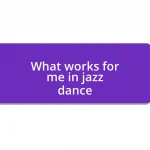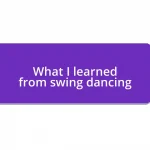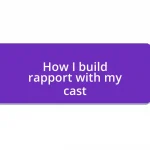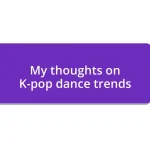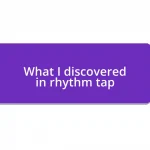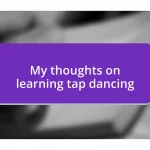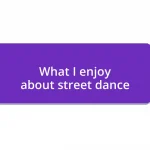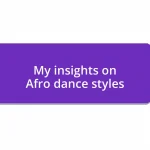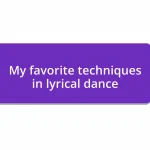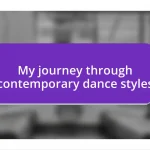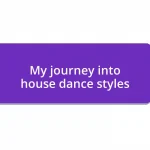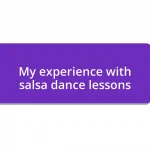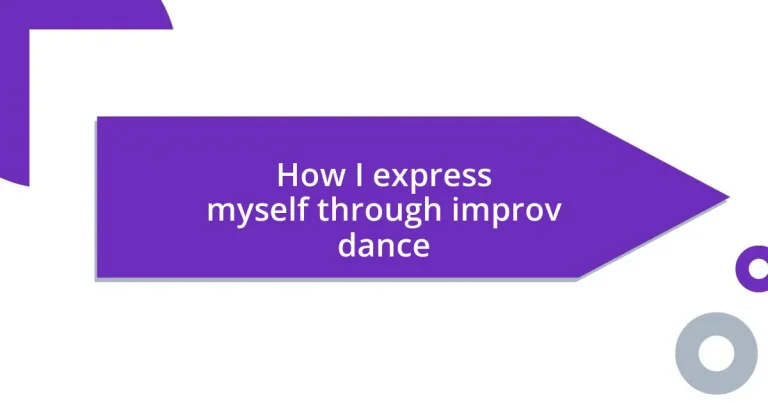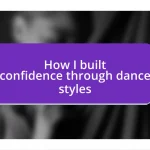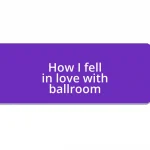Key takeaways:
- Improv dance fosters self-expression and emotional exploration, offering a therapeutic outlet for feelings that words cannot convey.
- Each dance session encourages personal growth by confronting fears and embracing vulnerability, leading to authentic expressions.
- Using music enhances the connection to emotions, allowing dancers to convey complex narratives through movement.
- Sharing the dance journey builds community, strengthens bonds, and creates a sense of belonging through shared vulnerability.
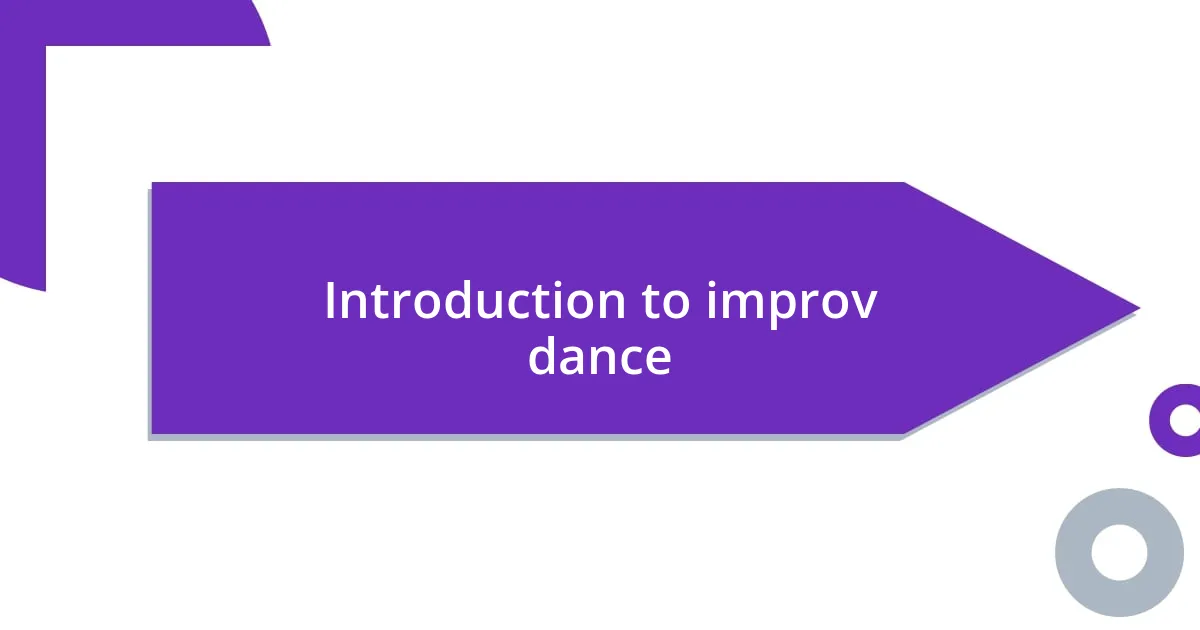
Introduction to improv dance
Improv dance is a beautiful art form that encourages spontaneous movement and self-expression. It invites dancers to let go of structured choreography and instead respond to their feelings, surroundings, and even the music playing in the background. I often find myself swept up in the moment, feeling liberated as my body moves without constraints—it’s a rush like no other!
One of the reasons I fell in love with improv dance is its emphasis on vulnerability and authenticity. Each session feels like a mini-therapy, where I can explore not just the rhythms but also my emotions. Have you ever felt the weight of stress lift as you lose yourself in movement? That’s the essence of improv dance—it’s not just about the moves, but about connecting with your inner self in a profound way.
Every performance is unique; no two moments are ever the same. I recall a particularly intense session where I allowed my fears to manifest in my movements, creating a powerful narrative of struggle and release. This spontaneity challenges me to embrace uncertainty and discover something new about myself each time I dance. Isn’t it fascinating how dance can be a mirror reflecting our emotional landscapes?
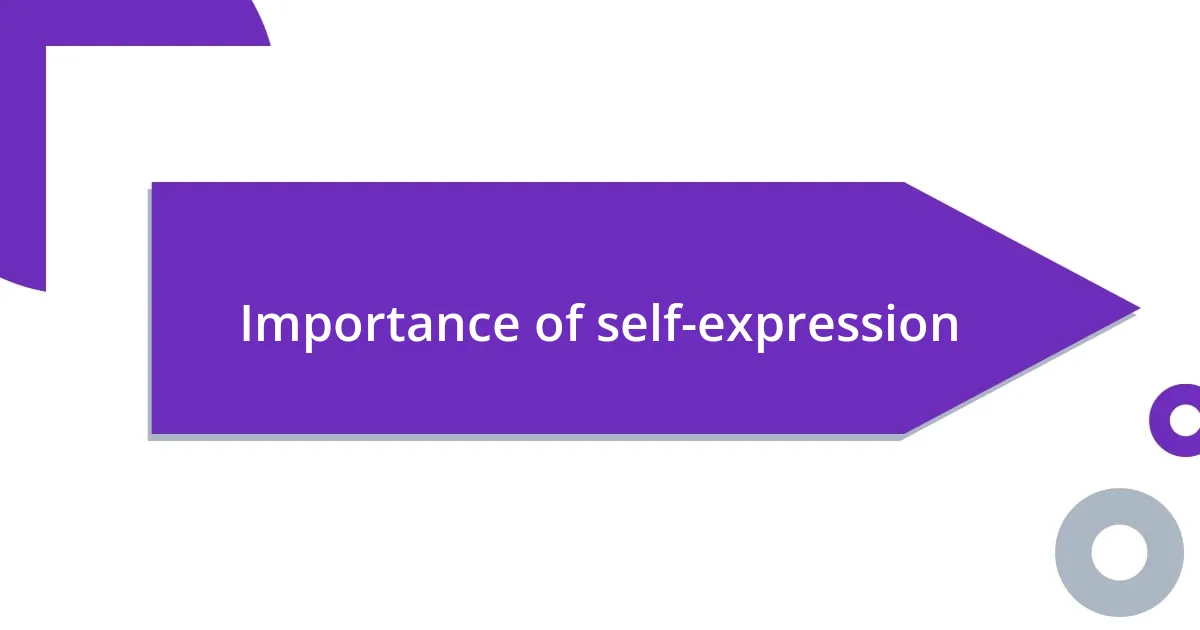
Importance of self-expression
Self-expression is vital for our mental and emotional well-being. When I dance, I let my body articulate feelings that words often fail to capture. For instance, during one session, I felt overwhelmed by joy and sadness simultaneously. As I flowed with the music, those emotions transformed into movement, allowing me to explore and communicate complexity on the dance floor. Isn’t it amazing how movement can convey what we can’t say out loud?
Moreover, self-expression fosters connection with others. In group improv dance settings, I often sense a shared energy, as each dancer responds not just to the music, but to each other. One memorable experience was when a stranger’s spontaneous leap inspired me to break away from my own reservations. That moment demonstrated the power of expression; it wasn’t just about personal release, but also about creating a collective experience. How often do we get the chance to connect so authentically with those around us?
Finally, embracing self-expression cultivates personal growth. Each improv session presents a new opportunity for self-discovery, helping me confront my fears and celebrate victories through movement. I vividly remember feeling nervous before performing in front of an audience. Yet, once I hit the stage and let the music guide me, I tapped into an inner strength I didn’t know I had. Isn’t it intriguing how this journey of expression can lead to profound transformations within us?
| Aspect | Description |
|---|---|
| Personal Insight | A deep understanding of one’s emotions, as experienced through dance. |
| Connection with Others | Building relationships through shared movement and expression. |
| Personal Growth | Developing confidence and self-awareness in dance and life. |
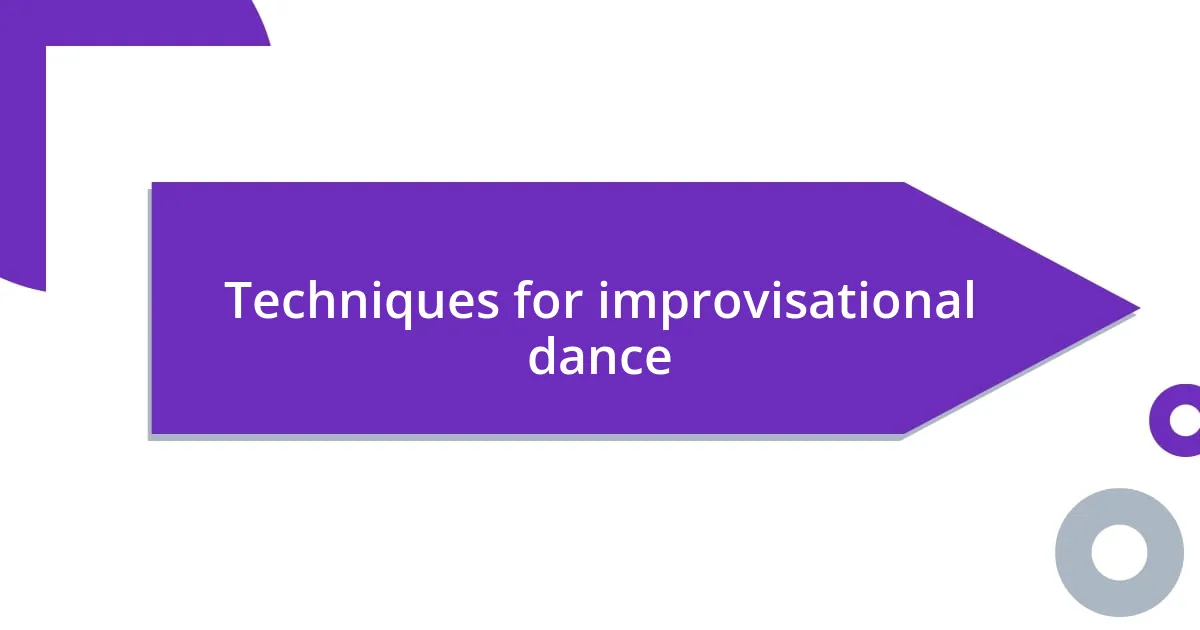
Techniques for improvisational dance
Techniques in improvisational dance are as diverse as the emotions they convey. When I step onto the dance floor without a plan, I often lean into a few core techniques that really allow me to tap into my body and spirit. One of my favorites is the concept of “word association,” where I let a single word—like “freedom” or “joy”—guide my movements. This approach not only adds depth to my performance but also allows me to create a narrative that resonates with both myself and my audience.
- Themed Movement: Choose a word to inspire your actions, facilitating a connection between emotions and physical expression.
- Body Awareness: Deepen your connection with your body by focusing on how each part moves, enhancing personal expression.
- Mirroring: Observe another dancer and reflect their movements; it fosters collaboration and can unlock new pathways in your own dance.
In addition, I find that incorporating elements from other dance styles can enrich my improv experience. For example, when I infuse some hip-hop moves into a contemporary improv session, I feel a rush of playful energy that transforms my entire performance. It’s exhilarating and often leads to unexpected moments of connection with the audience, as they resonate with that spontaneous joy. This is what I love about improv—every technique I choose becomes a new brushstroke on the canvas of my expressiveness, painting my unique story through dance.
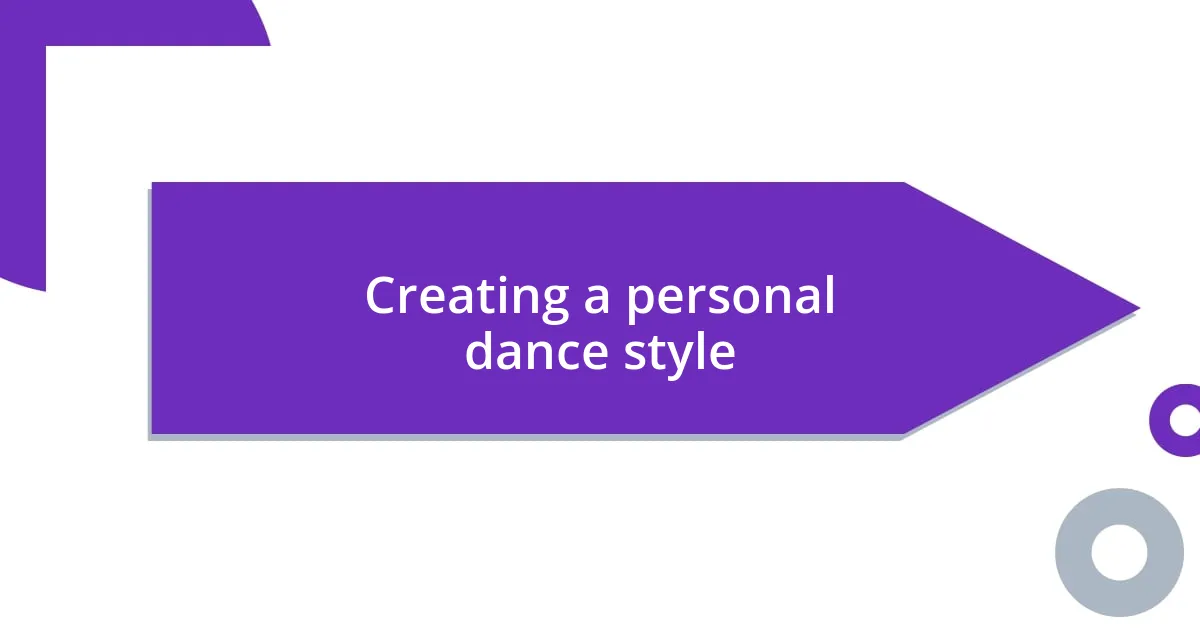
Creating a personal dance style
Creating a personal dance style is an exploration of individuality. I remember the first time I combined elements from my background in jazz with fluid contemporary moves. It felt like I was giving life to a new character, one that was utterly my own. Have you ever felt that spark when you blend unexpected influences? It’s invigorating!
In those early days of developing my style, I experimented without fear. I recall a moment during a workshop where I let my body follow a spontaneous impulse, turning a simple stretch into a full-blown twist and drop. This unplanned movement felt liberating and connected me deeply to the music. What I learned is that embracing those unexpected moments can lead to some of the most authentic expressions.
The beauty of creating a personal style lies in the journey itself. Each dance session becomes a canvas for self-exploration. Once, I spent an entire afternoon exploring how to express feelings of vulnerability through slow, deliberate movements. The result was powerful. I connected not just to my own experience, but I also felt that others in the space were moved by that raw emotional honesty. How often do we get opportunities to merge our feelings with art in such a profound way? It’s these interactions that help shape my dance style into something deeply personal and uniquely mine.
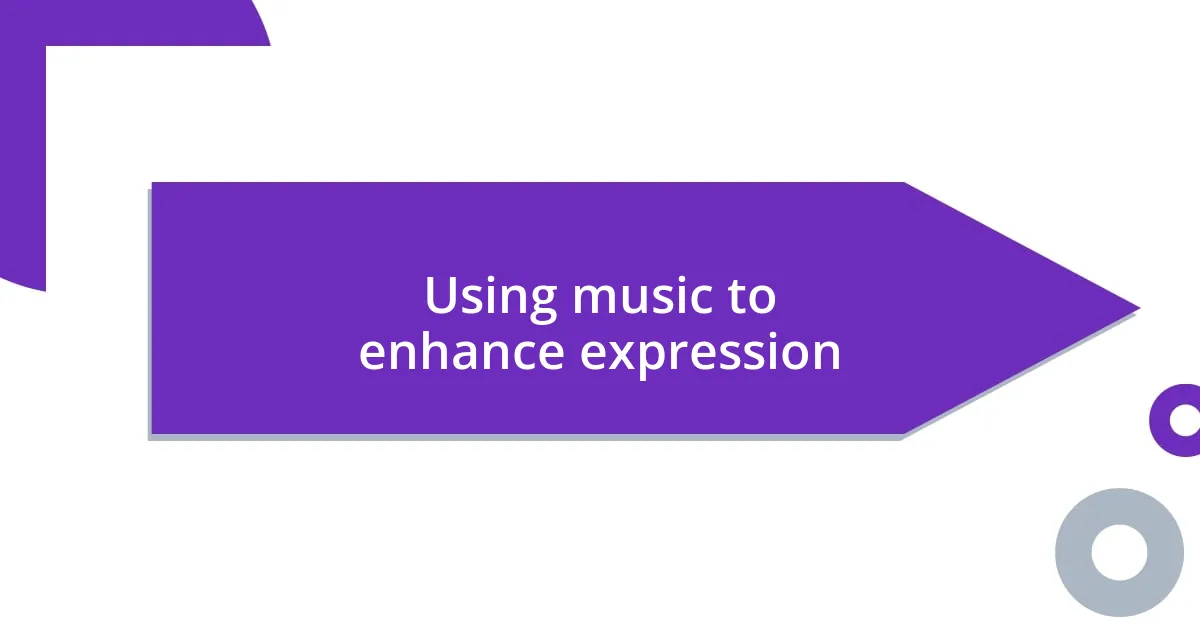
Using music to enhance expression
When I step onto the floor, the first thing I do is tune in to the music. It’s almost like a conversation with an old friend—reliable and filled with nuances. I often find that specific rhythms or melodies can awaken emotions I didn’t even know were there, urging my body to respond. For instance, when I dance to a soulful ballad, I often feel a deep sense of nostalgia that pulls me into a narrative, allowing my movements to flow with the music’s ebb and flow.
As I explore different genres, I notice how each one brings out unique aspects of my personality. One memorable time, I danced to an upbeat funk track, and my body reacted with spontaneous joy. I let myself get lost in the lively beats, and before I knew it, I was playfully interacting with the audience. This playful energy transformed my piece into a shared experience, sparking smiles and laughter all around. How amazing is it that a simple song can create such a profound connection?
Music serves as both a backdrop and a catalyst for my expression. I remember a day when I chose an ambient soundscape, and instead of moving quickly, I focused on stretching my movements in slow motion. This allowed me to experience the intricacies of each beat in a way that felt almost meditative. It’s in those moments of stillness within the music that I often discover my most profound expressions, breathing life into the quieter parts of my soul. Isn’t it fascinating how music can guide your inner world and shape your dance?
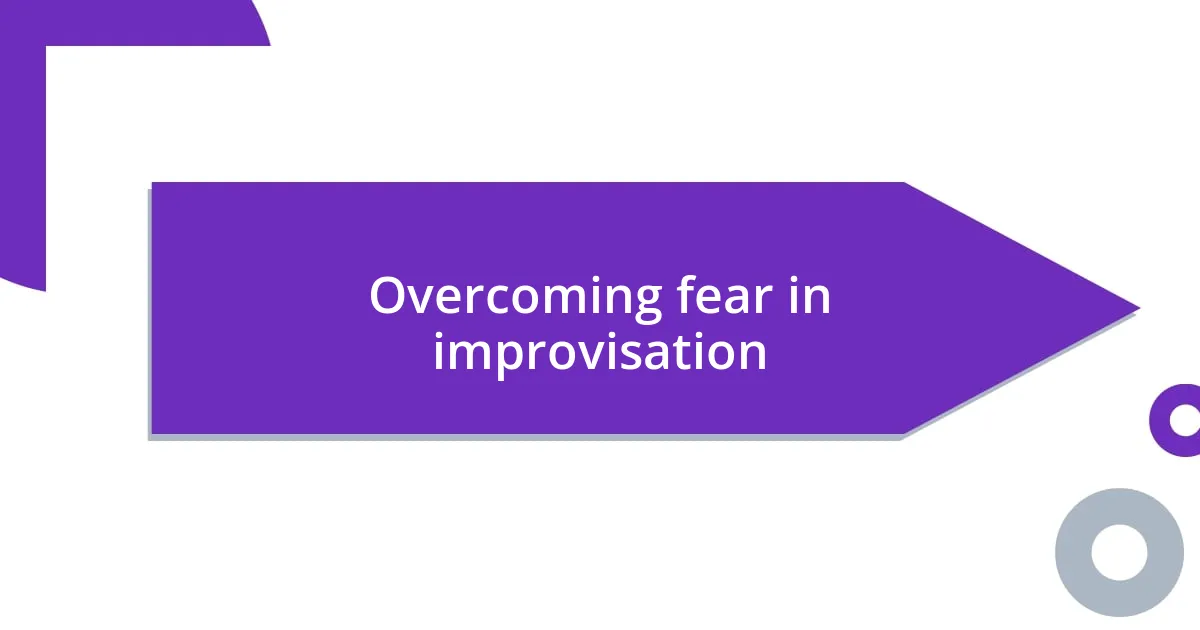
Overcoming fear in improvisation
Overcoming fear in improvisation is a journey that often feels daunting at first. I remember stepping into my very first improvised dance session, heart racing and palms sweaty. The thought of moving without a plan terrified me, yet I pushed through that initial anxiety. Have you ever faced a moment where fear threatened to hold you back, but you chose to leap anyway?
As I danced, I discovered that embracing vulnerability can transform that fear into freedom. One memorable evening, the music swelled, and I felt a spark igniting inside me. I let my body take the lead, shedding the fear of judgment, and suddenly, I was moving with a raw, unfiltered energy. Each wave of movement washed away the doubt, revealing pure, genuine expression. It was as if the dance floor became my sanctuary, allowing me to explore without boundaries. Isn’t it incredible how a shift in perspective can turn apprehension into a beautiful outpouring of creativity?
There are still moments of hesitation, though, especially when I’m trying something new. I recall a workshop where I was challenged to interpret an emotion I hadn’t yet explored in my dance. The fear of inadequacy crept in, whispering that I might fail to capture it. But instead of letting it paralyze me, I chose to dive into that fear. I let it fuel my movement, discovering a deeper layer of expression beneath the surface. How often do we find that what we initially fear can lead us to our most profound insights? Each time I conquer that fear, I emerge not only as a dancer but as a more authentic version of myself.
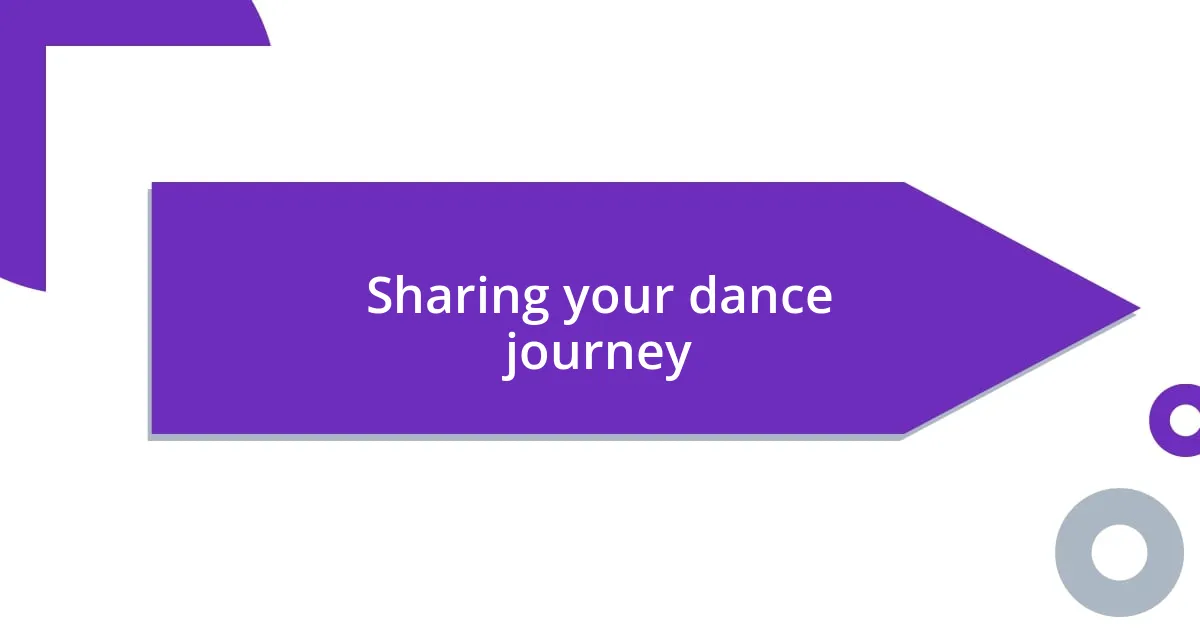
Sharing your dance journey
Sharing my dance journey has been a transformative experience, one that often feels like opening a window to my soul. I remember a time when I performed at a community event. Standing backstage, I felt a mixture of excitement and vulnerability—was I ready to reveal my inner self to others? As I stepped into the light, it felt like I was sharing a piece of my heart, and the audience’s energy gave me the courage to express myself fully. It’s incredible how sharing our dance can create bonds and sparks of understanding among strangers.
Within the dance community, I’ve found a rich tapestry of stories waiting to be shared. At a recent workshop, I connected with fellow dancers who opened up about their struggles and victories. Listening to their journeys reminded me that we’re all in this together, navigating the highs and lows of our artistic paths. Isn’t it powerful how vulnerability can invite connection? By sharing our experiences, we not only celebrate our individuality but also foster a sense of belonging—it feels like coming home.
Every moment spent sharing my dance journey adds layers to my identity. I will never forget a day when my friends and I decided to create a spontaneous performance in a park. As we danced under the sky, laughter intertwined with our movements, and passersby stopped to watch. It felt like a celebration of life itself, where our joy became an open invitation for others to join us. How often do we underestimate the impact of simply sharing our passions? In those instances, I’ve learned that our dance journey can inspire and uplift not just ourselves, but everyone around us.
